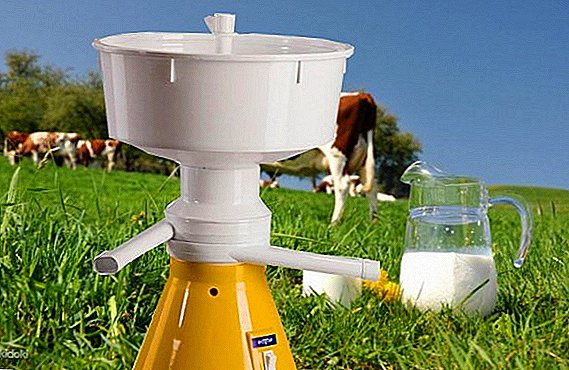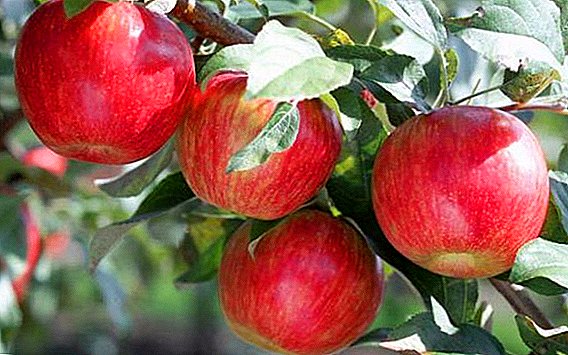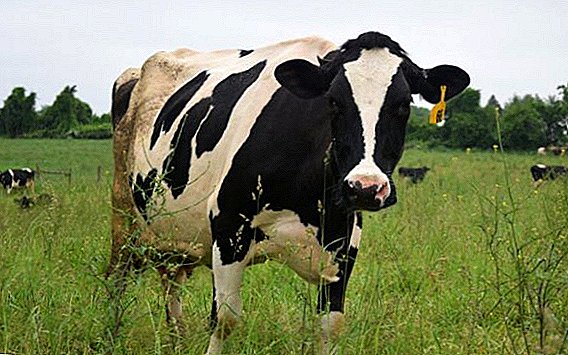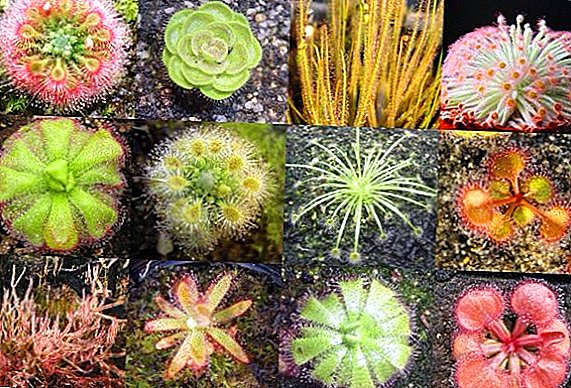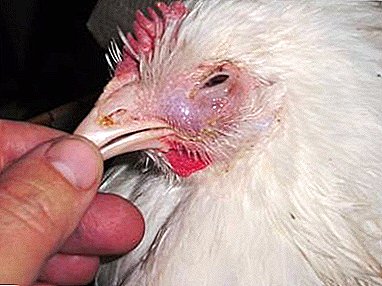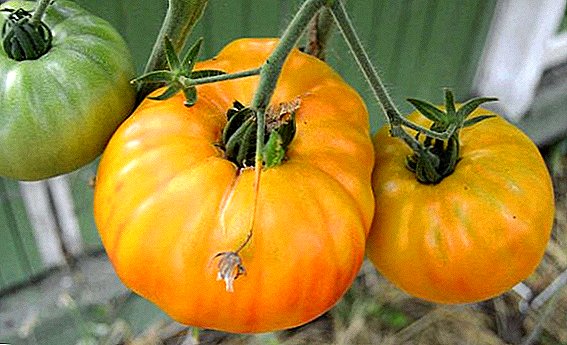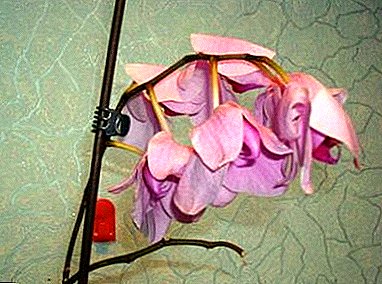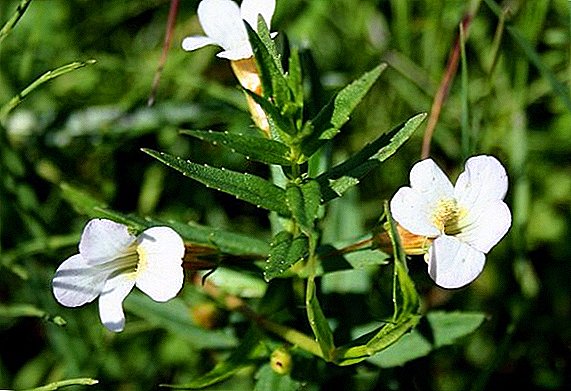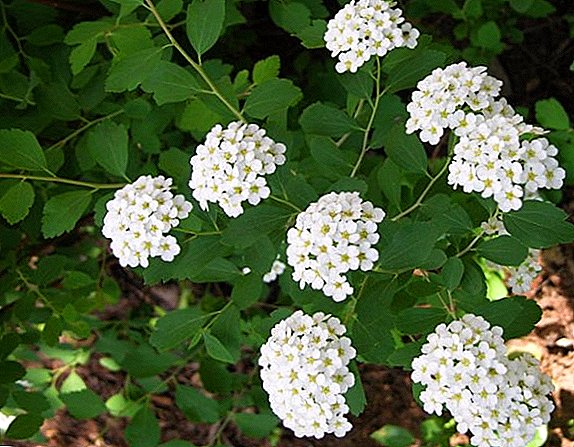 Spirea is a shrub of the Rosaceae family, growing in its natural environment in forests, on mountain slopes and in steppes. More than a hundred plant species are known, the distribution area is also quite wide: there are species adapted to warm climatic conditions, there are winter-hardy plant varieties.
Spirea is a shrub of the Rosaceae family, growing in its natural environment in forests, on mountain slopes and in steppes. More than a hundred plant species are known, the distribution area is also quite wide: there are species adapted to warm climatic conditions, there are winter-hardy plant varieties.
In this article we will talk about winter-hardy types of spirea, planting and caring for a plant in the Urals.
Spirea: plant description
Most varieties do not differ much in height, but all species grow rapidly. Spirea is a welcome guest in the garden, as it is not capricious in care, is not afraid of penumbra, although it is light-requiring, easily adapts after transplantation, pruning, practically does not get sick and is not damaged by pests. Most of the plants are winter-hardy, but there are also southern thermophilic species.
Spiraea plant - is lush shrubs with beautiful foliage and thick graceful inflorescences collected from small flowers. Depending on the type, spireas bloom in spring and summer, sometimes until late autumn. Color flowers may be white, pink, less red. The height of the bushes reaches more than two meters, there are also dwarf varieties. Stems are erect, drooping and creeping. The shape of the crown can be spherical, pyramidal and in the form of a cascade. The shape of the leaves is oblong, the edges with teeth, the length of leaves from two to ten centimeters.  The garden flower of spirea at flowering forms large inflorescences, the shape of which varies depending on the species in umbrella, racemose or thyroid. Small flowers have five petals, most often flowers are bisexual. After flowering fruits are formed - leaflets with winged seeds.
The garden flower of spirea at flowering forms large inflorescences, the shape of which varies depending on the species in umbrella, racemose or thyroid. Small flowers have five petals, most often flowers are bisexual. After flowering fruits are formed - leaflets with winged seeds.
Is it possible to grow spirea in the Urals
Climatic conditions in the Urals are different in different regions: the average winter temperature of the north is minus 22 degrees, the south is minus 16 degrees. Summer indicators for the northern regions - + 8, for the southern + 20 degrees. For the polar regions of the Urals is characterized by a long (up to eight months) and cold winter, summer, alas, short; in the south it lasts up to five months. If we talk about spirea, planting and care in the Urals, then it is possible to grow it here, preferably in the southern regions. The flora of the Urals is very diverse; such thermophilic plants as oak, beech, hornbeam, linden, maple, mountain ash, hazel, fragrant violet, shoes, honeysuckle, currant, hemlock grow in the west and south. Winter-hardy varieties of spirea in the Urals will take root, will grow well and multiply.
What varieties are suitable for growing spirea in the Urals
Consider the most winter-hardy and frost-resistant species of spirea.
Gray spirea - Sprawling shrub two-meter height with strong ribbed stems. The upper surface of the leaves is gray-green, paler below, the shape of the leaves is sharp at both ends. Inflorescences are thyroid, friable, white flowers. The species blooms in May, bears fruit in June.  Spirey Vanguta - two-meter shrub, cascade crown shape, diameter - two meters. Stems are flexible, thin, flowing. The leaves are not hairy, length up to 3.5 cm, oval shape with a serrated edge. Flowering begins in the third year of life, the flowers are white in color, it is noteworthy that in August re-flowering is possible. Tolerates shade, hardy, quickly growing. Preferred for this species of spirea breeding - cuttings. Looks great near ponds, among conifers, on the edge of large flower plantings.
Spirey Vanguta - two-meter shrub, cascade crown shape, diameter - two meters. Stems are flexible, thin, flowing. The leaves are not hairy, length up to 3.5 cm, oval shape with a serrated edge. Flowering begins in the third year of life, the flowers are white in color, it is noteworthy that in August re-flowering is possible. Tolerates shade, hardy, quickly growing. Preferred for this species of spirea breeding - cuttings. Looks great near ponds, among conifers, on the edge of large flower plantings.  Spiraea oak - distributed in Eastern European territories, in the Far East. Feels great on stony soils. The bush grows up to two meters, the stems are flexible, gently hanging down, forming a crown in the shape of a hemisphere. The leaves are ovate-oblong, with a serrated edge, the plate length is 5 cm. It blooms in May with a creamy color, the duration of flowering is 30 days. It is decorative in the fall: foliage gains golden-yellow color. Pruning spirea in the fall is well tolerated and stimulates the growth of new, stronger shoots.
Spiraea oak - distributed in Eastern European territories, in the Far East. Feels great on stony soils. The bush grows up to two meters, the stems are flexible, gently hanging down, forming a crown in the shape of a hemisphere. The leaves are ovate-oblong, with a serrated edge, the plate length is 5 cm. It blooms in May with a creamy color, the duration of flowering is 30 days. It is decorative in the fall: foliage gains golden-yellow color. Pruning spirea in the fall is well tolerated and stimulates the growth of new, stronger shoots.  Spirea average - lush shrub, different bright green foliage, spherical shape of the crown. May blooms with white flowers forming thyroid inflorescences. Easily adapts after transplantation, propagated by root scions. It is frost-resistant, is not afraid of a shadow. Fruit in the third year of life. Under natural conditions it grows in Siberia, the Far East and Central Asia.
Spirea average - lush shrub, different bright green foliage, spherical shape of the crown. May blooms with white flowers forming thyroid inflorescences. Easily adapts after transplantation, propagated by root scions. It is frost-resistant, is not afraid of a shadow. Fruit in the third year of life. Under natural conditions it grows in Siberia, the Far East and Central Asia.  Spirea birch common in Korea, Japan, Siberia and the Far East. It is named so for the similarity of foliage form with birch. This species is low - only 60 cm in height. Green leaves turn yellow in autumn, standing out on the site with a bright golden ball due to the rounded shape of the crown. The plant blooms in June, the first bloom comes in the fourth year. White or pale pink flowers are collected in thyroid inflorescences. Hardy, without shelter for the winter.
Spirea birch common in Korea, Japan, Siberia and the Far East. It is named so for the similarity of foliage form with birch. This species is low - only 60 cm in height. Green leaves turn yellow in autumn, standing out on the site with a bright golden ball due to the rounded shape of the crown. The plant blooms in June, the first bloom comes in the fourth year. White or pale pink flowers are collected in thyroid inflorescences. Hardy, without shelter for the winter.  Spirea billard spread from Arkhangelsk to the steppes of Central Asia and the Caucasus. Two-meter shrub with large, up to 10 cm long leaves. Leaves fleecy to the touch, gray-green color. Blooms bright pink flowers, gathered in dense pyramidal inflorescences. Flowering is long - from June to the first frost. Does not bear fruit, propagated by cuttings. Well tolerated shadow.
Spirea billard spread from Arkhangelsk to the steppes of Central Asia and the Caucasus. Two-meter shrub with large, up to 10 cm long leaves. Leaves fleecy to the touch, gray-green color. Blooms bright pink flowers, gathered in dense pyramidal inflorescences. Flowering is long - from June to the first frost. Does not bear fruit, propagated by cuttings. Well tolerated shadow. 
Did you know? The first mention of the spirea or meadowsweet is in the epic Sadko. They began to grow spiraea in 1586, the type of willow spirea was known. Later, in the XVIII century, they began to breed middle and oak spiraea, another hundred years later the birch spiraea appeared.
Features landing spirea in the Urals
Landing spirea in the Urals is carried out without any particular differences with other growing areas. The difference may be in terms, since the weather conditions in early spring in the southern regions are naturally milder than in the northern ones. Therefore, when planting a spiraeus in the Urals, indicators such as air and soil temperature and humidity will be determined.
Interesting! In 1839 it became possible to obtain acetylsalicylic acid from the spirea plant. Scientists discovered the glycoside of salicin in the stalks of the plant, which, when processed and transformed under the influence of chemical reactions, turns into aspirin.
Terms of planting spirea in the Urals
Spirea - unpretentious shrub and in planting and care. Plant the plant in spring or autumn. In the Urals, spring planting is carried out under the condition of warm soil, if planting is postponed for autumn, then it is desirable to complete the process by October.
Choosing a place for shrubs
 For spirea, you need to find the right location, then it will be easier to care for the plant in the Urals. Many species of spirea tolerate shade well, but in the climatic conditions of the Urals it is better to choose a site well lit by the sun. Heat and light will allow the plant to grow more actively, bloom and bear fruit.
For spirea, you need to find the right location, then it will be easier to care for the plant in the Urals. Many species of spirea tolerate shade well, but in the climatic conditions of the Urals it is better to choose a site well lit by the sun. Heat and light will allow the plant to grow more actively, bloom and bear fruit.
Attention! Consider also the peculiarities of the development of the root system of the spirea, it gives many offspring and takes up a lot of space, so the high-growth neighbors do not suit it. Spirea gets on well with juniper, thuja and low spruces.
Requirements for soil for growing spirea
Spirea prefers fertile and light soils, if there is heavy clay soil on the plot, “dilute” it with leafy, turfy soil, sand and peat, taken in equal parts.
How to plant spirey, landing pattern
Before planting spiraeus, inspect the seedlings. The roots should not be dry, a good seedling has a flexible root system, there are buds and no mechanical damage. If the roots are too long, they need to be shortened before planting, if the roots have dried up during storage, put them in a bucket of water.
The hole under the planting plant digging depth and a width of 50 cm. At the bottom of the need to lay drainage: expanded clay, broken bricks, pebbles. Drainage layer - at least 15 cm. If several plants are planted, the distance between them should be up to half a meter. For planting, a substrate is prepared in advance, which the seedling in the pit will fill up: leafy ground, peat and sand in proportions of 2: 1: 1. The plant is placed vertically, straighten the roots, so as not to bend, sprinkle with earth, leaving the root neck at the level of the surface. After planting spend watering and mulching.
Features of spiraea care in the Urals
 Plant care includes watering, loosening, mulching, spirea feeding and pruning. In the conditions of the Ural climate, the plant needs moderate watering - once a month there are 15 liters of water under a bush, and if the summer is dry - twice. After irrigation it is necessary to loosen the soil in the near-stem circle; the root system of the plant must breathe. Weeding from weeds is also desirable so that weeds do not take nutrients from spirea. How to feed spirea in early spring? For good development of the plant is useful fertilizing drug "Kemira" (120 grams per square meter). In the second half of the summer, they feed the infusion of mullein, adding to it 10 grams of superphosphate per ten liters of solution.
Plant care includes watering, loosening, mulching, spirea feeding and pruning. In the conditions of the Ural climate, the plant needs moderate watering - once a month there are 15 liters of water under a bush, and if the summer is dry - twice. After irrigation it is necessary to loosen the soil in the near-stem circle; the root system of the plant must breathe. Weeding from weeds is also desirable so that weeds do not take nutrients from spirea. How to feed spirea in early spring? For good development of the plant is useful fertilizing drug "Kemira" (120 grams per square meter). In the second half of the summer, they feed the infusion of mullein, adding to it 10 grams of superphosphate per ten liters of solution.
The plant is not strongly cut so as not to remove the kidneys. Once a formative pruning is performed, then only sanitary procedures. In the spring, remove the frozen tips of the branches. After flowering, cut off the old unpromising shoots, dry or damaged.
From pests spiraeus protect by spraying infusion of tobacco, a decoction of hot pepper or marigold. In serious cases, use insecticides.
Important! Formative pruning should be carried out in the spring so as not to weaken the plant before winter.
Spirea: how to save the plant in winter
 Spirea for the winter, despite the fact that it is a winter-hardy plant, it is necessary to shelter. The soil in the hull circle is well loosened, removing weeds. There is no need to cover the whole bush, but the root system needs to be warmed. It uses peat or sawdust, which is poured with a 20-centimeter layer, and spruce branches can be laid on top. It is especially good to insulate newly planted plants.
Spirea for the winter, despite the fact that it is a winter-hardy plant, it is necessary to shelter. The soil in the hull circle is well loosened, removing weeds. There is no need to cover the whole bush, but the root system needs to be warmed. It uses peat or sawdust, which is poured with a 20-centimeter layer, and spruce branches can be laid on top. It is especially good to insulate newly planted plants.
Spirea is easy to grow in the Urals. This plant does not require special care, tolerates low temperatures and blooms beautifully. In landscape design, spirea is used to create live fences, curbs, is beautiful in a single landing and among the undersized decorative conifers.


